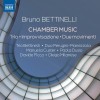Composers
Bruno Bettinelli (June 4, 1913 – November 8, 2004) was an Italian composer and teacher.
Bruno Bettinelli was born in Milan where he later completed his studies at the Conservatorio "G. Verdi" in Milan, under the tutelage of Giulio Cesare Paribeni and Renzo Bossi. He held the title of professor of composition at that same institute, and he trained many notable contemporary Italian musicians, including Claudio Abbado, Emiliano Bucci, Elisabetta Brusa, Gilberto Serembe, Danilo Lorenzini, Roberto Cacciapaglia, Bruno Canino, Aldo Ceccato, Riccardo Chailly, Azio Corghi, Armando Gentilucci, Riccardo Muti, Angelo Paccagnini, Bruno Zanolini, Silvia Bianchera, Umberto Benedetti Michelangeli, Caterina Calderoni, Barbara Rettagliati, Massimo Berzolla, Maurizio Pollini, Uto Ughi and many others. He also taught the Italian singer-songwriter Gianna Nannini.
He received many international awards for composition, including a prize from Accademia Nazionale di Santa Cecilia in Rome in the 1940s. He has also worked in musicology and music criticism.
His compositions are currently performed all over the world. Bettinelli's music is published primarily by Ricordi, Suvini Zerboni, and Sonzogno.
Bruno Bettinelli died in Milan in 2004 at the age of 91.
As a memoriam to Bruno Bettinelli, Milan's Edizioni Musicali European (EME), in collaborations with the magazines "Cartellina" and "Chorus," established a national competition for choral composition in his name.
An author of symphonic, choral, opera, and chamber music, his younger works incorporated a contrapuntal neoclassicism, influenced heavily by Igor Stravinsky, Paul Hindemith, and Béla Bartók, not to mention the Italian composers Alfredo Casella, Goffredo Petrassi and Gian Francesco Malipiero.
His later music evolved constantly, incorporating new elements, such as atonality and 12-tone music, to blend it into a free chromatic language, always expressing formal structures.
Of particular note are his choral works, as he collected and set many traditional Italian folk songs that had heretofore only survived through oral tradition.
Recently Added
Biography
Bruno Bettinelli (June 4, 1913 – November 8, 2004) was an Italian composer and teacher.
Bruno Bettinelli was born in Milan where he later completed his studies at the Conservatorio "G. Verdi" in Milan, under the tutelage of Giulio Cesare Paribeni and Renzo Bossi. He held the title of professor of composition at that same institute, and he trained many notable contemporary Italian musicians, including Claudio Abbado, Emiliano Bucci, Elisabetta Brusa, Gilberto Serembe, Danilo Lorenzini, Roberto Cacciapaglia, Bruno Canino, Aldo Ceccato, Riccardo Chailly, Azio Corghi, Armando Gentilucci, Riccardo Muti, Angelo Paccagnini, Bruno Zanolini, Silvia Bianchera, Umberto Benedetti Michelangeli, Caterina Calderoni, Barbara Rettagliati, Massimo Berzolla, Maurizio Pollini, Uto Ughi and many others. He also taught the Italian singer-songwriter Gianna Nannini.
He received many international awards for composition, including a prize from Accademia Nazionale di Santa Cecilia in Rome in the 1940s. He has also worked in musicology and music criticism.
His compositions are currently performed all over the world. Bettinelli's music is published primarily by Ricordi, Suvini Zerboni, and Sonzogno.
Bruno Bettinelli died in Milan in 2004 at the age of 91.
As a memoriam to Bruno Bettinelli, Milan's Edizioni Musicali European (EME), in collaborations with the magazines "Cartellina" and "Chorus," established a national competition for choral composition in his name.
An author of symphonic, choral, opera, and chamber music, his younger works incorporated a contrapuntal neoclassicism, influenced heavily by Igor Stravinsky, Paul Hindemith, and Béla Bartók, not to mention the Italian composers Alfredo Casella, Goffredo Petrassi and Gian Francesco Malipiero.
His later music evolved constantly, incorporating new elements, such as atonality and 12-tone music, to blend it into a free chromatic language, always expressing formal structures.
Of particular note are his choral works, as he collected and set many traditional Italian folk songs that had heretofore only survived through oral tradition.




